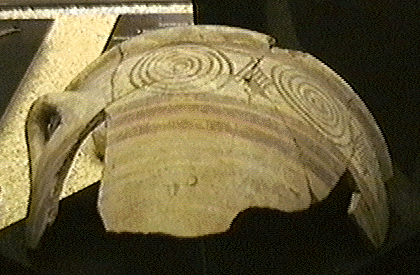

What archaeologists find
The most common artifact found is a potsherd. A potsherd is a broken piece of pottery. Believe it or not, these can tell archaeologists a good deal about a site. In fact, pottery is one of the most useful finds in archaeology. Found in the poorest of homes, and the richest of palaces and temple, its use in ancient Israel was commonplace and indispensable. Although pottery vessels are themselves fragile and easily broken, the hardened clay out of which they are made does not deteriorate and so can endure for thousands of years.
Probably the most important use of pottery, however, is in dating the stratum with which
it is associated. This is so because articles made of pottery, say oil lamps, have very
distinct sizes, shapes and decorations that can be closely related to specific time
periods. These subtle changes have now been charted for pottery as early as the Neolithic
period (6000-5000 BCE).
On almost every dig in Israel, thousands of pottery sherds
are collected. Archaeologists are able to determine from simply looking at the broken
sherds what time period they arise from. Pottery reading and reconstruction is analogous
to putting together a complicated jigsaw puzzle -- at first, all the tiny pieces look
identical, but eventually one is able to distinguish color patterns, shapes, and forms
from the different fragments. Though not as simplistic as a jigsaw puzzle, ceramic experts
do have basic criteria when analyzing a sherd.
 Form and function of a vessel is one of the first
differentiating features; a cooking pot looks different from an oil lamp, for example. The
pieces of the sherd are shaped differently. Other forms such as jugs, vessels, chalices,
pitchers, storage jars, plates and vessels for storing oil are all found in sites. Once
the form of the pottery is determined, the variants are then noted. Vessel shapes and styles changed over the years. Decoration on the pottery also varied through time. During
some periods the pottery was burnished or painted; in other periods decoration was
completely lacking. Painting can also reveal cultural differences; for instance,
Philistine pottery is often decorated with red and black paint, spiral and other unique
designs. (See photo below) How the pottery was manufactured was also a significant
feature in dating. Once humans learned how to combine clay and straw, they were able to
construct vessels. In early periods, pottery was handmade, later the potter's wheel was
used. Differences in material, types of clay, and firing techniques can reveal much about
the period and location in which it was manufactured.
Form and function of a vessel is one of the first
differentiating features; a cooking pot looks different from an oil lamp, for example. The
pieces of the sherd are shaped differently. Other forms such as jugs, vessels, chalices,
pitchers, storage jars, plates and vessels for storing oil are all found in sites. Once
the form of the pottery is determined, the variants are then noted. Vessel shapes and styles changed over the years. Decoration on the pottery also varied through time. During
some periods the pottery was burnished or painted; in other periods decoration was
completely lacking. Painting can also reveal cultural differences; for instance,
Philistine pottery is often decorated with red and black paint, spiral and other unique
designs. (See photo below) How the pottery was manufactured was also a significant
feature in dating. Once humans learned how to combine clay and straw, they were able to
construct vessels. In early periods, pottery was handmade, later the potter's wheel was
used. Differences in material, types of clay, and firing techniques can reveal much about
the period and location in which it was manufactured.
